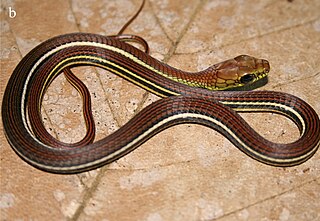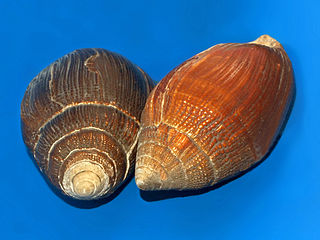
The flat-headed cat is a small wild cat with short reddish-brown fur. Its head is elongated, and its ears are rounded. Its slender body is 41 to 50 cm long with a tail of 13 to 15 cm, and it weighs 1.5 to 2.5 kg.

Dendrelaphis caudolineatus, commonly known as the striped bronzeback or grey bronzeback, is a species of colubrid snake found in Southeast Asia.

Freshwater swamp forests, or flooded forests, are forests which are inundated with freshwater, either permanently or seasonally. They normally occur along the lower reaches of rivers and around freshwater lakes. Freshwater swamp forests are found in a range of climate zones, from boreal through temperate and subtropical to tropical.

The smooth-coated otter is a freshwater otter species from regions of South and Southwest Asia, with the majority of its numbers found in Southeast Asia. It has been ranked as "vulnerable" on the IUCN Red List since 1996, as it is threatened by habitat loss, pollution of wetlands and poaching for the illegal wildlife trade. As the common name indicates, its fur is relatively smooth, and somewhat shorter in length than that of other otter species.

The large flying fox, also known as the greater flying fox, Malayan flying fox, Malaysian flying fox, large fruit bat, kalang, or kalong, is a southeast Asian species of megabat in the family Pteropodidae. Despite its scientific name, it feeds exclusively on fruits, nectar, and flowers, like the other flying foxes of the genus Pteropus. It is noted for being one of the largest bats. As with nearly all other Old World fruit bats, it lacks the ability to echolocate but compensates for it with well-developed eyesight.

Parosphromenus harveyi is a species of gourami endemic to Malaysia, where it is only known from Selangor. The most extreme freshwater habitats in Peninsular Malaysia is the peat swamp forest that consist of dark-coloured and highly acidic waters. Parosphromenus harveyi is known as licorice gourami, small labyrinth fishes located within the north Selangor peat swamp forest from the Tanjong Malim area in neighbouring Perak state at least one population distribution that exhibit a wide variety of morphological and behavioural traits. Species of the osphronemid genus Parosphromenus that stenotypic inhabitant of peat swamp forests and associated black water streams which has a very little light penetrates. Parosphromenus was established by Brown, 1987. Since 1950s, the additional taxa have been described on a sporadic basis and there are 20 recognised members at present.

Anax guttatus, the pale-spotted emperor or lesser green emperor, is a dragonfly of the family Aeshnidae.

Chalcorana labialis, also known as the white-lipped frog, is a species of "true frog" in the family Ranidae. As currently known, it is endemic to Peninsular Malaysia, although it might also occur in Singapore. Molecular data suggest presence of three distinct lineages in the same area, one of which is not closely related to Chalcorana labialis and which could represent an unnamed species.

Ellobium aurismidae, common name Midas's ear shell, is a species of medium-sized, air-breathing, saltmarsh snails, terrestrial pulmonate gastropod mollusks in the family Ellobiidae.

Emoia atrocostata, commonly known as the littoral whiptail-skink, mangrove skink, or littoral skink, is a species of lizard in the family Scincidae. It inhabits mangroves, back-beach vegetation and rocky shorelines. It is semi-aquatic and forages in tidal pools.

Orthetrum testaceum, common names Crimson Dropwing or Orange Skimmer. is an Asian freshwater dragonfly species belonging to the family Libellulidae.
Pseudogobiopsis oligactis, the bigmouth stream goby, is a species of goby from the subfamily Gobionellinae of the family Oxudercidae which is widespread in southern Asia.

Tytthoscincus is a genus of skinks. Originally defined to include a few species from the Philippines, the genus now includes many species from South-East Asia in general.
Tytthoscincus bukitensis, also known as the Fraser's Hill forest skink , is a species of skink. It is endemic to Peninsular Malaysia.
There are two species of skink named Fraser's Hill forest skink:
Tytthoscincus butleri, also known commonly as Butler's forest skink, is a species of lizard in the family Scincidae. The species is native to Malaysia and Thailand.
Tytthoscincus ishaki, also known commonly as the Tioman Island forest skink, is a species of lizard in the family Scincidae. The species is endemic to Tioman Island in Malaysia.
Tytthoscincus martae, the Hindu temple forest skink, is a species of skink. It is a leaf litter generalist endemic to Malaysia.

The giant hawker or the gigantic riverhawker, is a species of dragonfly in the family Aeshnidae. It is found throughout Sundaland, having been recorded on Thailand, Peninsular Malaysia, Singapore, Sumatra, and Borneo. It is the type species for the genus Tetracanthagyna.













